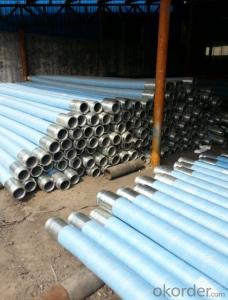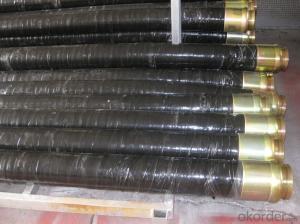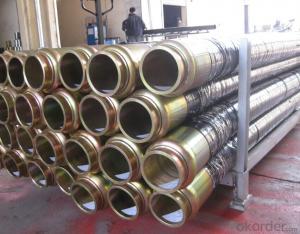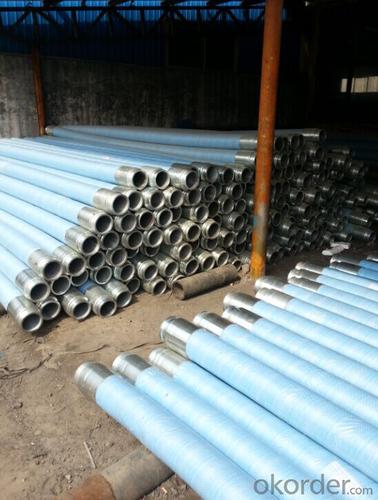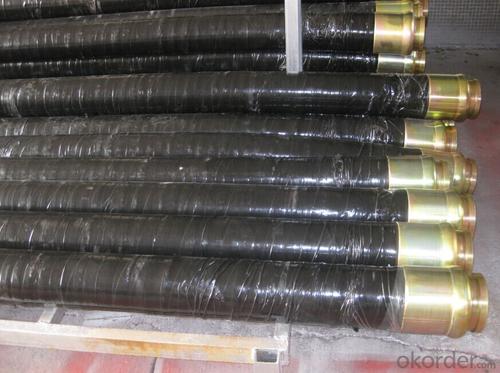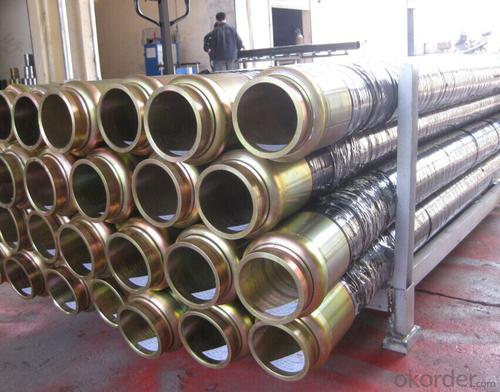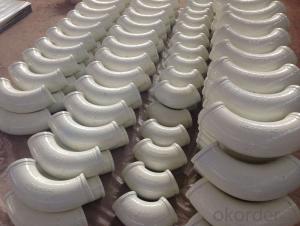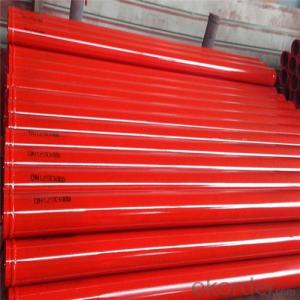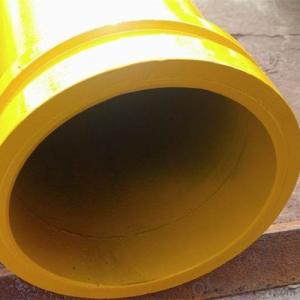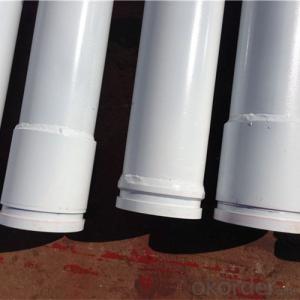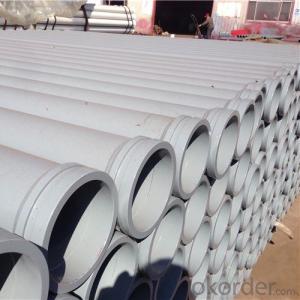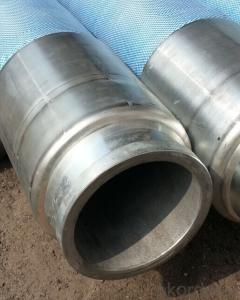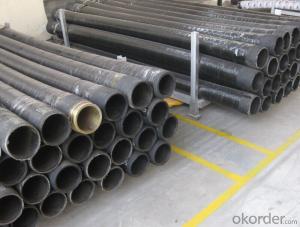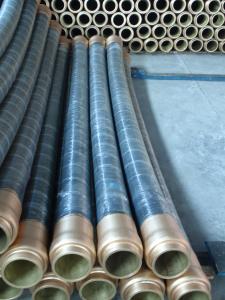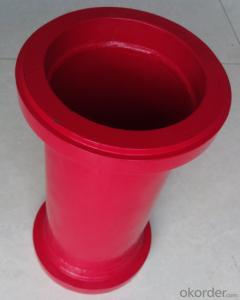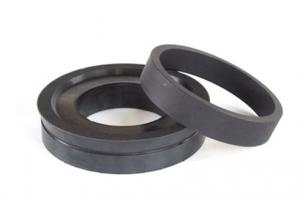6M*DN100 RUBBER END HOSE WITH ONE SIDE COUPLINGS WORKING PRESSURE 85 BAR
- Loading Port:
- Shanghai
- Payment Terms:
- TT OR LC
- Min Order Qty:
- 10 pc
- Supply Capability:
- 5000 pc/month
OKorder Service Pledge
OKorder Financial Service
You Might Also Like
Specifications
Putzmeister concrete pump end rubber hose
1. Size: DN150, DN125, DN100, DN80...
2. Length: 1~9m
Concrete pump end rubber hose PM &Schwing
Name | Specifications | Application | Flange diameter | Remarks |
Rubber hose | DN125*3000 | Concrete pump | 148/DN157mm | |
Rubber hose | DN150*3000 | Concrete pump | 148/DN157mm | |
High pressure | DN125*3000 | Concrete pump | 148/DN157mm | Two layers of steel wire |
High pressure | DN125*3000 | Concrete pump | 148/DN157mm | Four layers of steel wire |
High pressure | DN125*4000 | Concrete pump | 148/DN157mm | |
High pressure | DN150*3000 | Concrete pump | 175mm | |
| DN80*5000 | Mortar pump mini conctete pump | 98mm | |
| DN80*6000 | Mortar pump mini conctete pump | 98mm | |
| DN100*5000 | Mortar pump mini conctete pump | 124mm | |
| DN76*6000 | Fine stone concrete pump mini conctete pump |
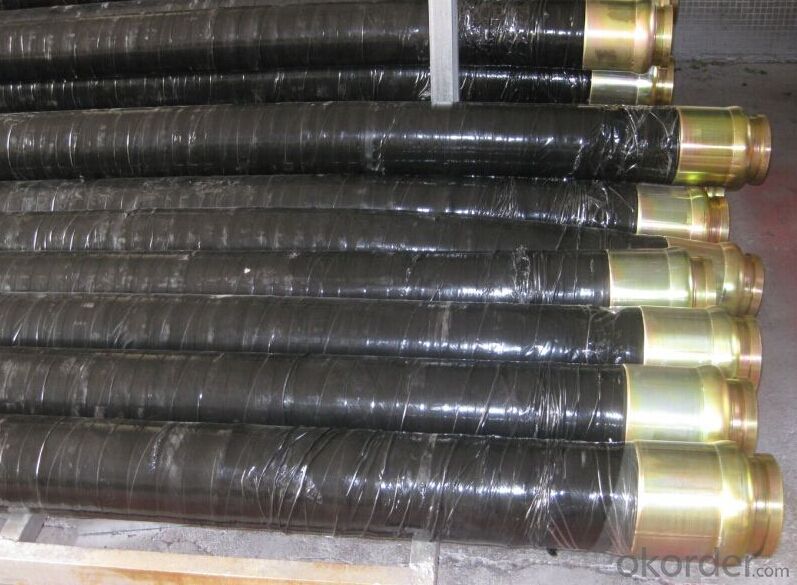
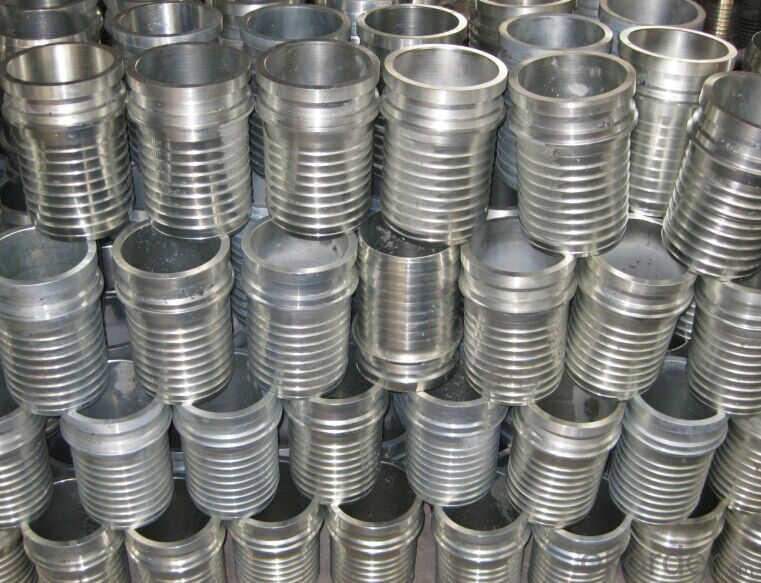
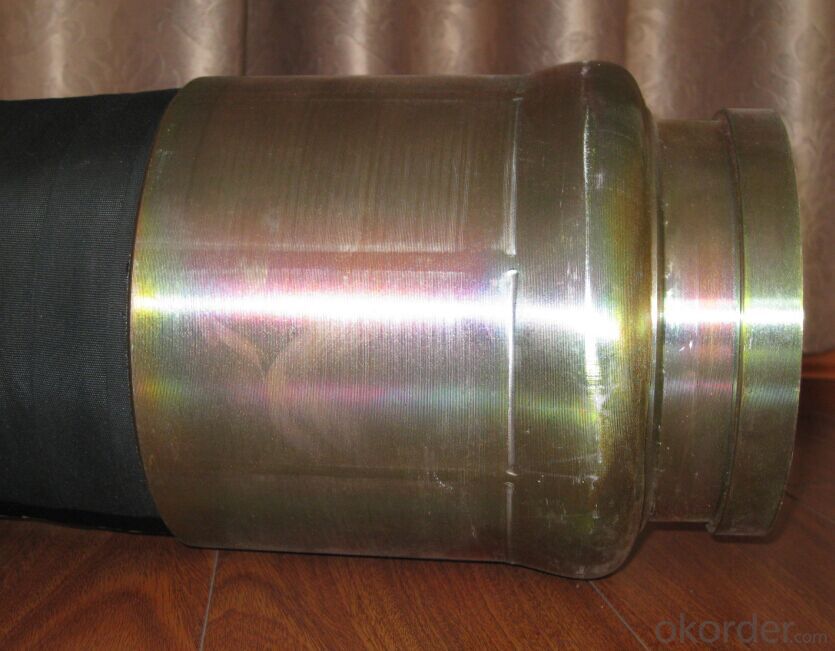
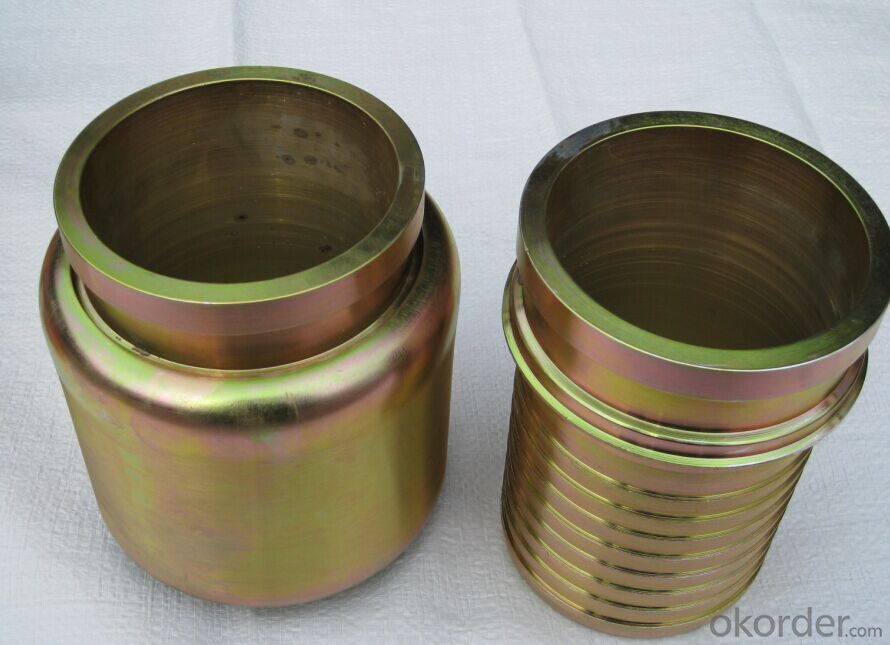
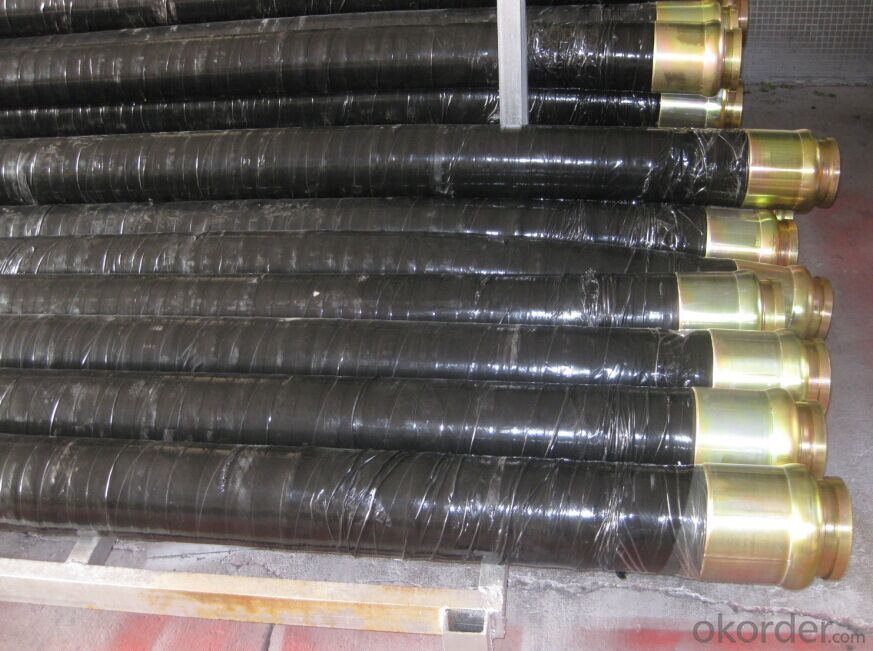
- Q: Are there any cost-effective alternatives to original concrete pump spare parts?
- Yes, there are cost-effective alternatives to original concrete pump spare parts available in the market. These alternatives, often referred to as aftermarket parts, are manufactured by third-party companies and offer similar quality and functionality as the original parts but at a lower price. However, it is crucial to ensure that the aftermarket parts are compatible with the specific make and model of the concrete pump to ensure proper fit and performance.
- Q: Can I get spare parts for concrete pump hopper agitators and vibrators?
- Yes, you can get spare parts for concrete pump hopper agitators and vibrators.
- Q: What are the preventive measures for concrete pump?
- In order to ensure the continuity of pumping concrete operation, and ensure the quality of concrete pouring, the interval between the operations should not be too long, so as to prevent clogging.
- Q: How can you determine when a concrete pump pipe needs to be replaced?
- There are several factors to consider when determining if a concrete pump pipe needs to be replaced. 1. Visual Inspection: Conduct a thorough visual inspection of the pipe. Look for any cracks, damage, or signs of wear and tear. Pay particular attention to the ends of the pipe where it connects to the pump and nozzle, as these areas are more prone to damage. 2. Performance: Observe the performance of the concrete pump. If you notice a decrease in pumping efficiency, such as reduced output or difficulties in maintaining pressure, it could indicate a problem with the pipe. Additionally, if there is excessive leakage or blockages in the pipe, it may be a sign that replacement is necessary. 3. Age and Usage: Consider the age of the pipe and the amount of usage it has undergone. Concrete pump pipes have a limited lifespan, and with time and extensive use, they can become worn out and lose their structural integrity. If the pipe is old and has been used extensively, it may be time to replace it. 4. Regular Maintenance and Repairs: If the pipe has undergone frequent repairs or maintenance, it could be an indication that it is nearing the end of its lifespan. While regular maintenance can prolong the life of a concrete pump pipe, if it has reached a point where repairs are becoming more frequent and costly, it may be more cost-effective to replace it. 5. Safety Considerations: Safety should be a top priority when determining if a concrete pump pipe needs replacement. If there are any significant structural issues or concerns about the pipe's ability to handle the pressure, it is essential to replace it to avoid any potential accidents or hazardous situations. Ultimately, the decision to replace a concrete pump pipe should be based on a combination of visual inspection, performance evaluation, age, usage, regular maintenance, and safety considerations. It is advisable to consult with a professional or experienced technician who can assess the pipe's condition and provide expert advice on whether replacement is necessary.
- Q: What are the indications of a faulty concrete pump hydraulic motor?
- There are several indications that can point to a faulty concrete pump hydraulic motor. Some common signs to look out for include: 1. Loss of power: If the hydraulic motor is not functioning properly, you may notice a significant loss of power in the concrete pump. The motor may struggle to generate enough force to pump the concrete effectively, resulting in slower or weaker output. 2. Excessive noise or vibrations: A faulty hydraulic motor may produce unusual noises or vibrations during operation. This could be a result of damaged internal components or misalignment, indicating a problem with the motor. 3. Fluid leaks: Hydraulic motors rely on the proper flow and pressure of hydraulic fluid to function correctly. If you notice any fluid leaks around the hydraulic motor or its associated components, it could be a sign of a faulty motor that needs attention. 4. Overheating: When a hydraulic motor is faulty, it may overheat due to increased friction or internal malfunctions. If you notice excessive heat coming from the motor or associated components, it is essential to address the issue promptly to avoid further damage. 5. Inconsistent or jerky movement: A faulty hydraulic motor may cause the concrete pump to operate inconsistently or jerkily. This can result in uneven pouring or difficulty in controlling the flow of concrete, indicating a problem with the motor's performance. 6. Increased energy consumption: If the hydraulic motor is faulty, it may require more energy to operate properly. This can lead to a noticeable increase in energy consumption, which can be observed through higher electricity bills or a greater strain on other parts of the pump's system. It is important to note that these indications may vary depending on the specific make and model of the concrete pump hydraulic motor. It is always recommended to consult the manufacturer's guidelines or seek professional assistance to diagnose and address any issues with the hydraulic motor effectively.
- Q: What is the function of a concrete pump hopper filter?
- The function of a concrete pump hopper filter is to prevent large debris and foreign objects from entering the pump system, ensuring smooth and uninterrupted flow of concrete and protecting the pump from potential damage.
- Q: Can concrete pump spare parts be customized according to specific requirements?
- Yes, concrete pump spare parts can be customized according to specific requirements. Customization allows for the adaptation of parts to meet specific needs such as size, shape, material, or functionality. This enables better compatibility and enhances the efficiency and performance of concrete pumps.
- Q: What are the common issues that require replacement of concrete pump spare parts?
- Common issues that often require the replacement of concrete pump spare parts include wear and tear from continuous use, damage caused by debris or foreign objects in the concrete mix, corrosion due to exposure to harsh chemicals or weather conditions, and malfunctioning or worn-out components such as seals, valves, or pistons.
- Q: How does a concrete pump clamp work?
- An integral part of a concrete pump is the concrete pump clamp, which is utilized to securely fasten and stabilize the concrete delivery pipeline. Its function is to firmly grasp the pipeline, eliminating any potential movement or leakage throughout the concrete pumping procedure. Typically comprised of two primary components, the concrete pump clamp consists of the clamp body and the wedge. The clamp body, constructed from durable steel, possesses a curved structure tailored to the pipeline's shape. Equipped with bolts or knobs, it can be tightened or loosened to attach the clamp to the pipeline. In contrast, the wedge is a metal piece that is inserted into the clamp body. Its purpose is to apply pressure to the pipeline when the clamp is tightened. By manipulating the bolts or knobs, the wedge is pushed deeper into the clamp body, effectively squeezing the pipeline and establishing a secure grip. The secure grip achieved by the concrete pump clamp is essential as it guarantees a seamless and uninterrupted flow of concrete without any leaks or disruptions. It upholds a consistent and steady movement of concrete from the pump to the desired destination. Furthermore, the clamp contributes to the stability of the pipeline, preventing any shifting or displacement during the pumping process. In summary, the concrete pump clamp assumes a crucial role in the efficient and safe operation of a concrete pump. It ensures the secure placement of the concrete delivery pipeline, facilitating a smooth and uninterrupted concrete pumping process.
- Q: What are the advantages of using OEM (Original Equipment Manufacturer) concrete pump spare parts?
- Using OEM (Original Equipment Manufacturer) concrete pump spare parts offers several benefits: 1. Quality Assurance: OEM spare parts are made by the same company that produces the original equipment, ensuring that they meet the same high-quality standards as the original components. By using OEM parts, the concrete pump will perform optimally with minimal risk of breakdowns or failures. 2. Compatibility: OEM spare parts are specifically designed to fit perfectly with the original equipment. They are built to exact specifications and dimensions, allowing for seamless integration with the concrete pump. This compatibility ensures proper and efficient functioning of the parts. 3. Reliability: OEM spare parts undergo extensive testing by the manufacturer to ensure their reliability and durability. This reduces the likelihood of premature failure or wear, resulting in reduced downtime and maintenance costs. The reliability of OEM parts also minimizes the risk of accidents or injuries caused by faulty equipment. 4. Warranty Coverage: Many OEM spare parts come with a manufacturer warranty, providing protection against defects or failures. This warranty gives customers peace of mind and assurance that they are investing in high-quality components. In case of any issues, the manufacturer typically provides support and assistance. 5. Technical Support: OEM manufacturers usually offer technical support and assistance to customers using their spare parts. This support is invaluable for troubleshooting issues, providing guidance on installation or maintenance, and optimizing the performance of the concrete pump. Non-OEM parts may not offer the same level of support. 6. Long-Term Cost Savings: While OEM spare parts may have a higher upfront cost compared to non-OEM alternatives, they often prove to be more cost-effective in the long run. Their superior quality and reliability result in fewer breakdowns, reduced maintenance expenses, and extended equipment lifespan. Using OEM parts also helps maintain the resale value of the concrete pump. In conclusion, the advantages of using OEM concrete pump spare parts include quality assurance, compatibility, reliability, warranty coverage, technical support, and long-term cost savings. By choosing OEM parts, users can ensure smooth and efficient operation of their concrete pump while minimizing risks and maximizing their investment's return.
Send your message to us
6M*DN100 RUBBER END HOSE WITH ONE SIDE COUPLINGS WORKING PRESSURE 85 BAR
- Loading Port:
- Shanghai
- Payment Terms:
- TT OR LC
- Min Order Qty:
- 10 pc
- Supply Capability:
- 5000 pc/month
OKorder Service Pledge
OKorder Financial Service
Similar products
Hot products
Hot Searches
Related keywords
